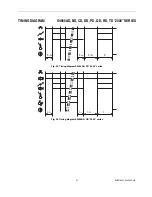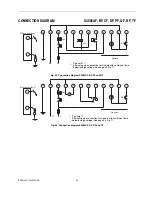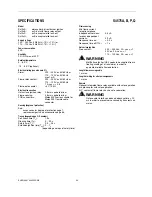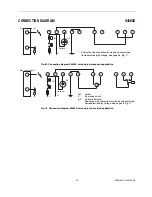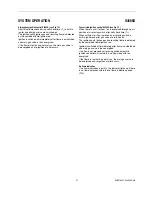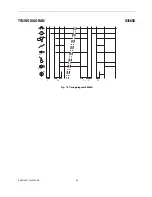
45
EN2R-9031 0402R15-NE
SYSTEM OPERATION
S4565PV, QV, RV, TV
General
The S4565PV, QV, RV, TV ignition controls can provide
closed-loop sparking, sparking to ground or combined
sparking and flame sensing.
Lock-out reset
The S4565PV, QV, RV, TV ignition controls can be reset by
interrupting the permanent live or by pressing the reset
button for at least 1 s.
The S4565RV, TV versions with prepurge can be reset by
interrupting the heat demand for at least 1 s.
The application of this type of control is therefore restricted to
those applications where resetting by switching off the heat
demand is allowed by European appliance standards. Reset
of an appliance in lock-out must occur by means of a
conscious manual action and not by means of automatic
devices like thermostats or timers.
NOTE 19.: If permanent alarm output:neon indicator with
integral resistor >150 k
Ω (
max 1 mA)
Suffix PV (see Fig. 59.)
When there is a call for heat a self check period (T
c
) plus
waiting period (T
w
) elapse before the built-in igniter and gas
valve are switched on.
The ignition spark ignites gas and resulting flame is detected
by the flame rod.
After flame establishing a predetermined, extended ignition
time can be included.
If flame is not established within the safety time (T
s
), the
ignition control locks out or makes a restart depending on the
number of start trials.
If the flame is lost during normal run, the ignition control
repeats start sequence.
Suffix QV (see Fig. 60.)
As PV except flame relay contact or opto coupler is activated
after flame detection.
Suffix RV (see Fig. 61.)
When there is a call for heat a self check period (T
c
) elapses
if the air proving switch is in the no air position.
After T
c
the fan starts running.
When sufficient air flow is proven by the air proving switch,
the built-in igniter and gas valve are switched on.
The ignition spark ignites gas and resulting flame is detected
by the flame rod.
After flame establishing a predetermined, extended ignition
time can be included.
If flame is not established within the safety time (T
s
), the
ignition control locks out or makes a restart depending on the
number of start trials. This is including dynamic air check.
If the flame is lost during normal run, the ignition control
repeats start sequence.
If no air is proven by the air proving switch, the ignition control
stays waiting (optional lock-out on no air can be included).
Suffix TV (see Fig. 62.)
As RV except flame relay contact or opto coupler is activated
after flame detection.
Suffix RV with prepurge (see Fig. 63.)
When there is a call for heat the fan starts running through
the no air position of the air proving switch.
When sufficient air flow is proven by the air proving switch, a
self check period (T
c
) plus a prepurge period (T
p
) elapse
before the gas valve and the built-in igniter are switched on.
The ignition spark ignites gas and resulting flame is detected
by the flame rod.
Ignition is switched off.
After flame establishing a predetermined, extended ignition
time can be included.
If flame is not established within the safety time (T
s
), the
ignition control locks out or makes a restart at prepurge
depending on the number of start trials.
If the flame is lost during normal run, the ignition control
repeats start sequence at prepurge.
If no air is proven by the air proving switch within the
prepurge time (T
p
) the ignition control stays in waiting mode
with fan running.
Suffix TV with prepurge (see Fig. 64.)
As RV with prepurge except flame relay contact or opto
coupler is activated after flame detection.

